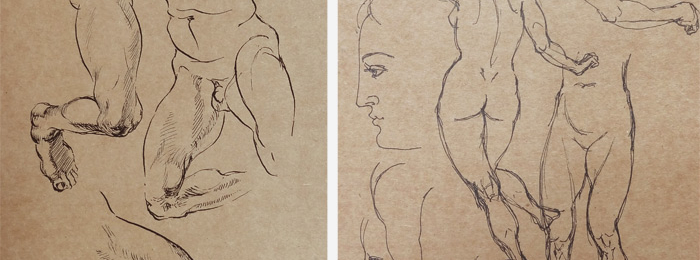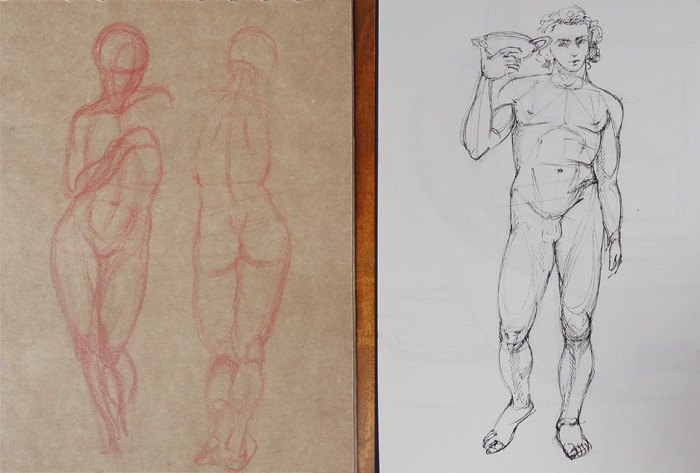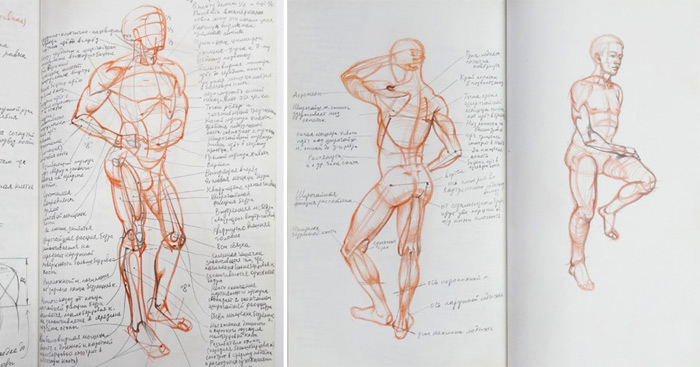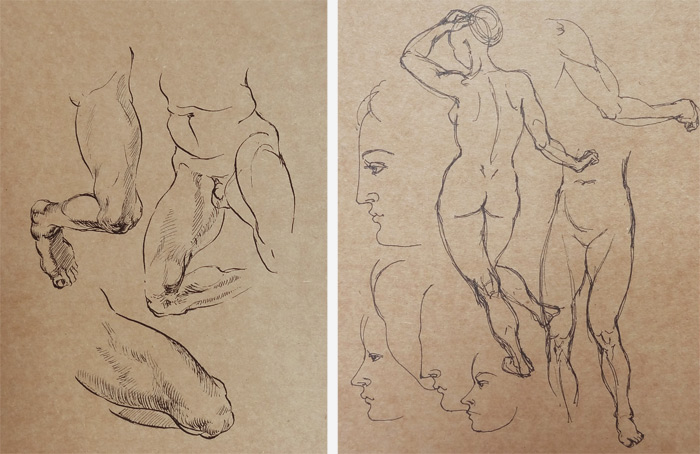What is the purpose of gesture drawing

Question from Roxane
At almost every life drawing session, we start with several one-minute, two-minute and five-minute gesture drawings. I find these short sessions very frustrating. Please correct me on this and give me some goal for each short session.
Drawings from Vladimir London’s sketchbooks
Hi Roxane,
Many thanks for your question.
Yes, it can be frustrating not being able to finish a sketch as you wanted in 2-5 minute sessions.
The purpose of gesture sketching is to sharpen your eye and hand, learn how to judge shapes and proportions, and be able to capture the overall look and pose of the model without any details.
Here are 2-minute gesture drawings:

Here are some good tips on how to approach a gesture sketch:
• Draw small-scale figures (3-5 inches in size). You can fit several sketches on one sheet of paper. This serves two purposes: First, you can see the whole drawing in a glance without moving your eyes; and second, it is faster to draw small images. With time and practice, you may want to scale up and draw bigger gesture drawings.
• Depict the main characteristic shape/pose of the figure. A gesture sketch can be just one or two lines that give a general idea or suggestion of the model rather than a description of smaller shapes and volumes.
• Always set a meaningful task for a sketch. You can portray a continuous line from head to toe, capture the angle of the pose, or maybe solve a question of foreshortening. Every pose will present something different, so your tasks will vary as well.
• Even in small and fast sketches, draw what you know; do not copy what you see. This is especially important for avoiding mistakes in proportions when under the pressure of time. Do not copy the body outline-by-outline; instead, analyze its shape and draw what you have learned. For example, you know that the geometrical middle of a standing figure is in the region of the pubic bone; make sure you keep this proportion accurate in your sketch. You know that the distance from the toes to the top of the knee cap is the same as from the knee cap to the top of the pelvis, and it is equal to the distance from the pubic bone to the top of the breastbone. Judge these proportions by eye or use a pencil to measure.
• You don’t have to draw a full figure in every sketch. Sometimes, you can draw a portrait, a hand or foot, or a torso.
• Use graphite pencils for gesture drawing. Charcoal is not precise enough. Sanguine and red pencils might look more attractive, but this can be challenging, as you may overlook mistakes. Your main goal of doing gesture sketches is to learn how to draw figures and improve your drawing skills, not to create perfect artworks. Learning can only happen when you see your drawing mistakes and work on them, thus improving your skills. “Lovely-looking” red sanguine camouflages mistakes and makes it harder for you to learn.
• Do not use an eraser in fast pencil drawings. 2-5 minute sketches are too short when it comes to fixing mistakes by erasing. If you need to fix something in your sketch, draw it over.



Of course, gesture sketching cannot replace longer studies of life drawing. Even 20-40 minute drawings are not long enough to obtain proficient art skills in figurative drawing. You also need to do many session life model studies (up to 20 hours).
We hope this helps and gives you some direction on how to approach gesture drawing.
To improve your drawing skills, enroll in the Drawing Academy course »
Knowledge of human anatomy is a must for a figurative artist.
To learn human anatomy fast, visit the Anatomy Master Class »
![]() Kind regards,
Kind regards,
Natalie Richy and Vladimir London
Drawing Academy tutors
- Receive 15 new videos monthly (45 in total)
- Incredible discount – $4,164
- Bonuses - Fine Art eBooks and Videos
- Drawing Academy Diploma of Excellence after course completion in 3 months
- Personal coaching by Drawing Academy Tutors
- Lifetime membership. Free after the 3rd month
- Immediate access to all 45 video lessons
- Incredible discount – $4,198
- Bonuses - Fine Art eBooks and Videos
- Drawing Academy Diploma of Excellence after course completion in 3 months
- Personal coaching by Drawing Academy Tutors
- Lifetime membership. No more payments


THANKS VERY HELPFUL